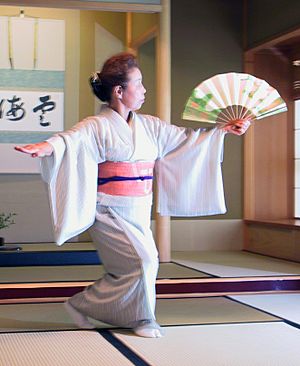Japanese traditional dance facts for kids
Japanese traditional dance is a beautiful art form with a long history. There are two main types: Odori and Mai. Odori started during the Edo period (a time when Japan was ruled by shoguns). It grew from exciting Kabuki plays, which were often performed by men. Mai developed in western Japan. It came from Noh drama, a more serious and ancient type of theater, also performed by men. While Mai was traditionally danced by men, today it's often performed by women. You might see Mai dances in homes, not just on big stages.
One special type of Mai dance is called Kyomai, which means "Kyoto style dance." It began in the 1600s during the Tokugawa period, another name for the Edo period. Noh drama, its music, and dances were greatly influenced by the elegant ways of the Japanese Imperial Court in Kyoto. Kabuki drama, and therefore Odori, was a more common type of entertainment for everyone. Even so, both forms of dance are very traditional when we look at them today.
Images for kids
-
Two maiko performing a dance
-
An awaodori dance troupe at Osu in Nagoya, Aichi.
-
Katsushika Hokusai published suzume odori in his manga in 1815.
See also
 In Spanish: Danza tradicional japonesa para niños
In Spanish: Danza tradicional japonesa para niños








